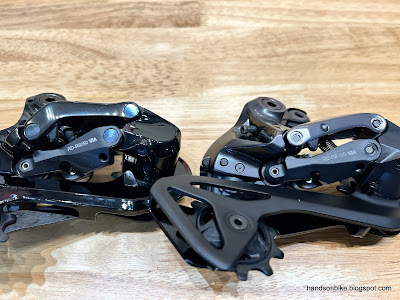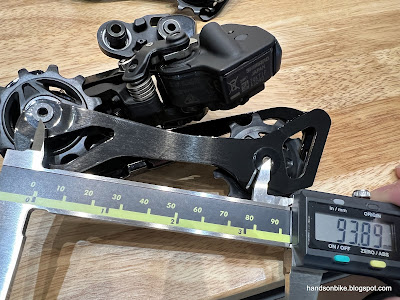Here is another comparison post, and a very important one at that. This may answer a common dilemma that many cyclists have: Should I get Dura-Ace or Ultegra components? As a rough guide, Ultegra components are about half the price of Dura-Ace, but nearly all the performance and just a little bit more weight, depending on the type of component.
In the previous post, I compared the Dura-Ace and Ultegra cranksets, and concluded that the Ultegra R8100 crankset is the better choice due to the very small weight savings of the Dura-Ace R9200 crankset.
Now, let's compare the Di2 rear derailleur and front derailleur of Dura-Ace vs Ultegra. Check out the differences and similarities, and decide for yourself! Let's start with the rear derailleurs.
As Di2 electronic components, the model numbers are as shown.
Dura-Ace Di2 rear derailleur on the left, Ultegra Di2 rear derailleur on the right.
For a start, the link pivots on the Ultegra are not sealed with a sticker to improve the appearance. Not an issue for me as the bottom side is hardly visible anyway.
Same motor unit is used on both the Di2 rear derailleurs, so the shifting performance should be the same.
Same part layout around the motor unit, as they share many common parts.
Saver spring mechanism looks to be exactly the same.
Comparing the cage inner plate, Ultegra (right) uses aluminium while Dura-Ace (left) uses carbon fibre for weight savings.
Dura-Ace RD-R9250 weighs only 216 grams, which is very lightweight.
Ultegra RD-R8150 weighs 46 grams more at 262 grams, which is still pretty light. A lot cheaper too.
Ultegra cage set is longer, as seen on the right. I will explain this difference below.
Dura-Ace cage length is about 94 mm, chain capacity is 37T.
Ultegra cage length is 100 mm, chain capacity is 39T.
From this 6 mm difference in cage length, we can conclude that the Ultegra rear derailleur has a slightly larger chain capacity, due to the longer cage. Why the difference? Let me explain the background first.
Dura-Ace is designed, first and foremost, as a groupset for competitive cyclists, to be used during professional races. For Dura-Ace R9200 groupset, the cranksets available are 50-34T, 52-36T, and 54-40T. The most common chain ring size used by the professionals is 54-40T, which is the biggest size for maximum speed and efficiency. You will also notice that the front difference is only 14T (54 - 40 = 14), as compared to 16T for the other two chain ring specifications.
As for the 12 speed cassette options, 11-30T and 11-34T are available, with 11-30T being more common, and 11-34T being used for mountainous stages. The rear difference of the 11-34T cassette is 23T (34 - 11 = 23), while the 11-30T cassette has a 19T rear difference.
Adding up the most commonly used front difference (14T) and largest rear difference (23T) gives 37T, which is the maximum rated chain capacity of the Dura-Ace rear derailleur. In other words, the Dura-Ace rear derailleur allows the pro cyclist to use a 54-40T crankset with a 11-34T cassette, with sufficient chain capacity. Switching to the smaller 11-30T cassette does not require the rear derailleur or chain to be changed, which saves a lot of time for the mechanics.
Let me list out the combinations and respective total chain capacity required:
- 54-40T crankset with 11-30T cassette: 33T (most common)
- 54-40T crankset with 11-34T cassette: 37T (mountainous stages)
- 50-34T or 52-36T crankset with 11-30T cassette: 35T (uncommon in pro peloton)
- 50-34T or 52-36T crankset with 11-34T cassette: 39T (rare in pro peloton)
From the combinations above, you can see that the Dura-Ace rear derailleur is able to cover most of the use cases, EXCEPT for the 4th case, where the 39T requirement exceeds the 37T available.
This 4th case is quite rare in the professional peloton, as they usually will not need a low 1:1 gearing even in the mountains. If this 4th case does happen, the Di2 logic system automatically blocks out the top 2 gears (smallest sprockets 11T and 12T) on the cassette, when the small chain ring (34T or 36T) is selected up front. This limits the chain capacity required to 37T, and prevents the chain from losing all tension, as the rear derailleur cage is not long enough to cover the whole gear range.
I hope I have not lost you at this point with my explanations. In summary, the Dura-Ace rear derailleur cage length is purposely made shorter to save weight, while being just long enough to cater for the most commonly used gear combinations.
On the other hand, the Ultegra R8100 crankset is available only in 50-34T and 52-36T combinations, both with 16T front difference. The gear combinations for Ultegra is thus reduced by half as shown.
- 50-34T or 52-36T crankset with 11-30T cassette: 35T
- 50-34T or 52-36T crankset with 11-34T cassette: 39T
Given that the Ultegra groupset is designed more for serious enthusiasts instead of the professionals, the 39T capacity requirement will be quite common. The weight requirement is also not as stringent as Dura-Ace. Therefore, it makes sense for the Ultegra rear derailleur to have a longer cage to boost the chain capacity up to 39T, at the expense of a little more weight compared to Dura-Ace.
Moving on, let's check out the Dura-Ace and Ultegra front derailleurs.
Dura-Ace front derailleur on the left, Ultegra front derailleur on the right.
The Dura-Ace version has an aluminium outer plate to save weight, as compared to steel for Ultegra and every other grade below that.
Note that the Dura-Ace front derailleur that I have has a black coloured outer plate. Apparently this is only found in earlier batches, as newer Dura-Ace front derailleurs has changed the surface treatment to a dark chrome colour instead of black.
Inner view of the rear derailleurs. The inner plates are not a common part as there are small differences that can be seen.
Same link set construction and material, although the surface treatment is different (matte vs gloss, anodized vs painted).
Construction looks to be the same from the front as well.
From the rear, can see that the Dura-Ace front derailleur uses some hollow pivots to save weight.
From the bottom, can see the two rivets (right side) that are used to join the outer and inner plates of the Dura-Ace chain guide.
The Dura-Ace chain guide is made in two pieces with two different materials, aluminium for outer plate and steel for inner plate. That is why it requires rivets at the front and tail ends to join the two pieces together.
The Ultegra chain guide is made of a single piece of stamped steel, folded to form the outer and inner plates, and is only riveted together at the tail end to complete the structure.
Dura-Ace front derailleur FD-R9250 only weighs 95 grams.
Ultegra front derailleur FD-R8150 weighs a bit more at 111 grams, a 16 gram increase.
Based on weight, the rear derailleurs have a more significant weight difference of 46 grams. As for the front derailleurs, the weight difference between Dura-Ace and Ultegra is only 16 grams, even less than the weight difference of the cranksets (20 grams).
Once again, we see that the Ultegra components are a lot better value, because they cost half the price of Dura-Ace. Using Ultegra crankset + rear derailleur + front derailleur, instead of Dura-Ace, adds a total of 82 grams (20 + 46 + 16 = 82), but at a big cost saving of around SGD 1,200, based on recommended retail prices. With that price difference, more weight can be saved by upgrading the wheelset or changing other parts of the bike instead.




















Hi there,
ReplyDeleteMay I ask if I can put the 9250 cage on 8170 derailleur in order to save weight? Will there be any issue cause I am using 50/34 & 11/34
Not sure if the internal mounting point is the same at the rear derailleur side. Probably not worth the effort. The Dura-Ace rear derailleur cage is also shorter, and can't accommodate your gear combination.
DeleteCan dura ace pulley wheels be used in ultegra cage?
ReplyDeleteShould be ok
Delete